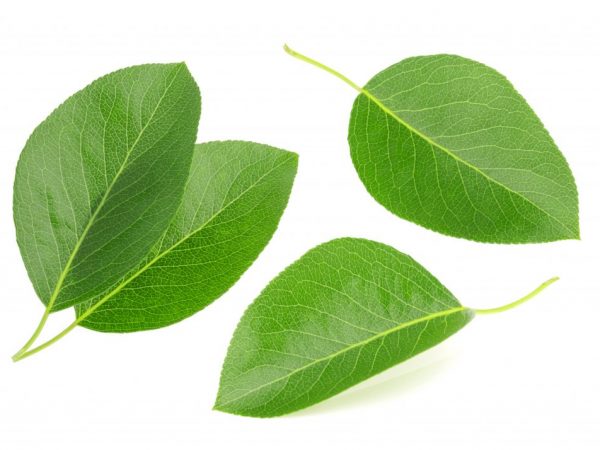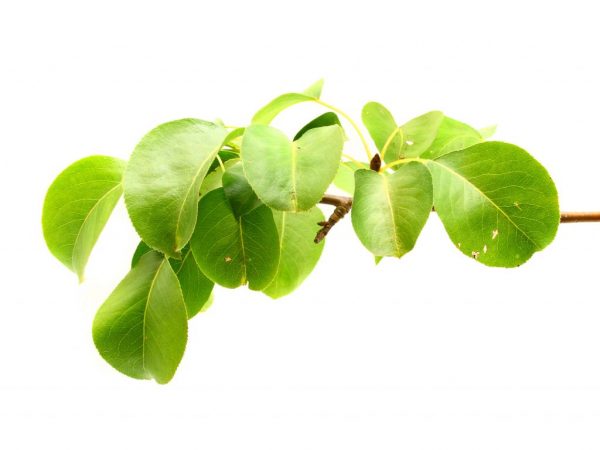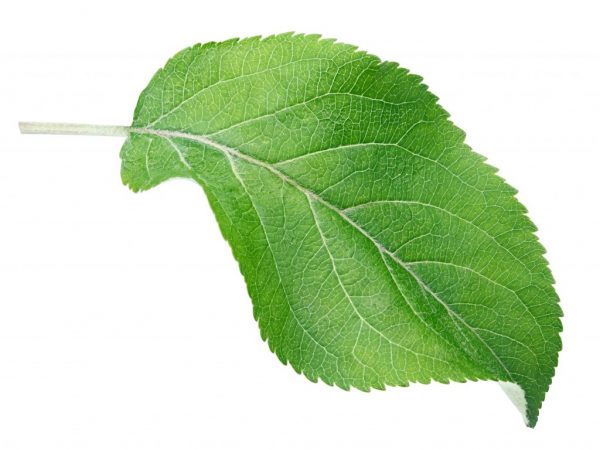What pear leaves look like
The pear leaf is part of the shoot and is essential for the fruit tree. Acts as the organ of photosynthesis. As an object of botany study, a leaf plate can tell a lot about a plant, the features of its life cycle, places of growth, about diseases and metabolic disorders.

Pear leaves
Botanical characteristic
The genus Pear belongs to the Pink family and includes 69 species. There are much more varieties, because they have been cultivated for more than one millennium.
Not all pears are trees, there are also pears-shrubs. Also, in addition to fruit pears, there are many decorative ones.
In summer, healthy leaf plates on top have a rich green color and they also shine. The underside is also green, but with a bluish tint. By autumn, due to a lack of light and warmth, the foliage turns red, and the underside takes on an orange tint. Coloring nuances vary from variety to variety.
The form
The shape of the leaf plate is also very dependent on the variety. Most often it happens:
- ovoid;
- obovate;
- round;
- elliptical;
- oblong.
The length varies, but usually it is not more than 10 cm.
The edges
The edges of the leaves also differ depending on the variety:
- whole;
- toothed;
- with blunt or rounded teeth (crenate edge);
- with sharp teeth (serrated edge);
- serrate-crenate;
- ciliate-serrate (when the denticles end in a thin "cilium");
The latter option is very rare, typical only for the Ussuri varieties.
The top of the plate is always sharpened, but in different ways: gradually, suddenly, with a short tip, a long tip.
Relief

The relief of the leaf depends on the variety
The relief of the plate, again, surprises with its variety: in some varieties it is straight, in others it is twisted or folded along the central vein and even wavy (as, for example, in the Bere Ardanpon variety, which has seemingly corrugated leaf edges).
In general, the shape of the leaves, like that of other fruit trees and shrubs, corresponds to a high level of moisture and gas exchange between the plant and the environment. The leaf arrangement is always spiral.
Leaves are petiolate by type. This means that each leaf sits on a petiole, and is not attached to the stem, as, for example, in cereals, chicory, flax (this type is called "sessile").
The venation is pinnate. This implies that small ones extend to the sides from the central vein; the latter are located parallel to each other.
Chemical composition
According to the characteristics, pear leaves contain the following substances:
- vitamins, and the presence of vitamin C is especially prominent;
- flavonoids;
- arbutin (this glycoside is present in the leaves of some other plants, for example, lingonberry);
- tannins;
- minerals (iron, magnesium, potassium, phosphorus, boron, nitrogen and others).
Beneficial features
Vitamin C in the composition is a natural antioxidant. These include flavonoids - plant pigments. In terms of structure, flavonoids are polyphenols, and due to unsaturated bonds, they are just able to neutralize free radicals.
Arbutin is known for its antiseptic effect. In the era before antibiotics, decoctions and teas from lingonberry leaves were almost the only treatment for infectious and inflammatory diseases of the urinary tract. Teas and decoctions of pear leaves acted similarly. True, their use was not so widespread.
Currently, arbutin is used in cosmetology as a whitening agent, because it interferes with the exchange of melanin.
This property has long been used in folk medicine: the leaves of pear trees were steamed, brewed, insisted and used in the form of lotions for skin diseases.
With dermatitis, a beneficial effect can also be expected from the presence of tannins and antioxidants in plant raw materials.
Some researchers are now talking about a certain ability of arbutin to increase the risk of developing cancer in humans. So far, there is no exact confirmation, as well as an exact refutation of these assumptions.
Using

Leaves are used to brew tea
Fresh and dried leaves, twigs, as well as small pear fruits are used as an independent infusion for drinks (herbal tea) or added to tea infusions for aroma.
The most common composition of herbal tea: take young fresh leaves of apple and pear in equal volumes, mix and brew 2 tablespoons of this plant material in 400 ml of boiling water. Insist 10 - 15 minutes, filter, cool. Drink during the day to quench your thirst along with other drinks.
Useful properties include saturation of the body with antioxidants, minerals, antiseptic effect on the urinary tract, and an increase in the body's immune resources. Of course, plant materials must come from an environmentally friendly area, where there is no pollution of soil, water, air, and also be free from dirt and dust.
Recently, when interest in arts and crafts has sharply increased, the beautiful and bright leaves that the autumn pear tree bestows are of special artistic value for those who like to compose winter compositions from dried plants: panels, collages, winter bouquets.
Diseases of pears
The most common pear diseases include:
- scab;
- sooty fungus;
- powdery mildew;
- rust.
All of these diseases are caused by fungi. They require the prompt treatment of plants with special means. And in the fall, when the harvest from pear trees has already been harvested, some of the fruits have been eaten, and some have been preserved for the winter, preventive treatment with antifungal agents should be carried out annually.
Symptoms
By the changed appearance of the foliage, you can see what diseases the tree is affected by:
- With scab, fungal spores are located in the form of yellowish-brown clusters on the underside of the leaf.
- When infected with a sooty fungus, pear leaves turn black.
- With powdery mildew, they turn white, dry out, curl into tubes.
- Rust, justifying its name, manifests itself as "rusty", that is, yellow-orange-brown convex layers on the leaves.
- When aphids are affected, the leaf plates curl, deform, dry out.
- The variegated color of the leaf plates indicates the defeat of chlorosis. This is a disease in which photosynthesis is impaired. The causes of chlorosis can be different, including viruses, bacteria, and fungi. There is also non-infectious chlorosis.
- Can be determined by the appearance of foliage and metabolic disorders. For example, redness not in the autumn, but in the summer is an indicator of a lack of phosphorus.
Conclusion
Now you know everything about pear leaves. This tree with a properly shaped crown looks very elegant.
If you have a pear in your garden, learn to "read" its condition, carefully examining not only each fruit, but each leaf. With proper plant care, you can get ripe and tasty fruits every year.



